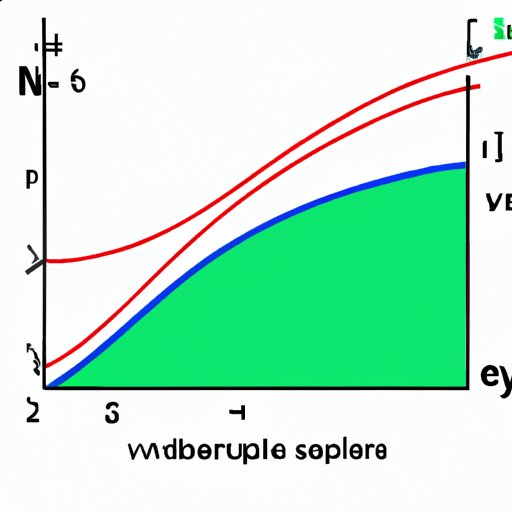Introduction
When it comes to linear equations, one of the most important concepts to understand is slope. Slope is essentially the measure of steepness or incline between two points on a line. It not only plays a critical role in understanding linear equations, but also has numerous real-world applications. In this article, we will explore what slope is, how to calculate it accurately, and why it is essential to have a solid understanding of slope in fields like architecture, engineering, physics and more.
Understanding the Basics: Exploring the Concept of Slope in Linear Equations
Before diving into slope calculations, it is essential to understand linear equations. A linear equation is an equation whose solution is a straight line. The equation can be written in various forms, but one of the most common forms is the slope-intercept form: y = mx + b. Here, m represents the slope of the line, and b represents the y-intercept of the line.
Slope is a crucial concept in linear equations, and it determines the angle of incline of the straight line. It is represented as a ratio of change in the y-coordinate (rise) to the change in the x-coordinate (run) between any two points on the line.
From Rise over Run to Y-Intercepts: A Beginner’s Guide to Slope Calculations
Calculating slope is relatively simple and is usually performed using the rise-over-run method. You can find the slope of a line by selecting any two points on the line and calculating the ratio of the difference in the y-coordinates to the difference in the x-coordinates. The slope formula can be represented as:
Slope = (y2 – y1) / (x2 – x1)
Variations of the linear equation exist such as point-slope form, which is another common way of expressing a linear equation. This form is y – y1 = m(x – x1). Point-slope form is very useful when you know one point on the line and the slope.
The y-intercept is another essential component of slope calculations. Y-intercept refers to the point at which the line crosses the y-axis and is represented by the value of ‘b’ in the slope-intercept equation, y = mx + b. To find the y-intercept, one can set x = 0 in the equation y = mx + b and solve for b.
Why Slope Matters: Real-World Applications in Mathematics and Beyond
The importance of having a firm grasp of slope extends beyond the classroom. Understanding slope is imperative in fields such as architecture, engineering, and physics, where calculating the slope of a line, angle of inclination, and other properties of lines is crucial in design and building.
For example, slope calculations can be used to determine the dimensions of a roof or the rise and run of stairs. Slope is also used to calculate the gradient of a sloping surface, the pitch of a road, and to analyze the data in scientific experiments. In addition, slope calculations can be used to predict future outcomes based on the current trend of the data.
Graphing 101: Visualizing Slope and its Relationship to Linear Equations
The graph of a linear equation can help visualize the slope of the line. When you graph a line using the slope-intercept form, the slope is the rate of change of y with respect to x. The steeper the line, the greater the rate of change.
Graphing a linear equation is relatively simple, start by finding the y-intercept (b) and plot the point (0, b) on the y-axis. From there, we use the slope to find one or more additional points and connect the dots to form a straight line.
The concept of slope as the rate of change can also be represented graphically. For example, if we have a graph in which the x-axis represents time, and the y-axis represents distance, then the slope is the rate at which distance changes with respect to time, or the velocity.
Common Mistakes and How to Avoid Them: Tips for Finding Slope Accurately
While calculating slope may seem simple, in practice, there are common mistakes that can lead to incorrect results. Some errors include dividing by zero, confusing the coordinates, or mismatching signs.
Fortunately, by following a few simple tips, you can avoid these mistakes and find slope accurately. First, ensure you understand which two points represent your x and y-coordinates. Secondly, be mindful of the signs when calculating the difference in the y and x-coordinates. It’s also essential to consider scenarios where there is no slope or an undefined slope, such as vertical lines.
Going Beyond the Basics: Advanced Applications of Slope in Calculus and Physics
Calculus and physics rely heavily on the concept of slope. In calculus, the slope is referred to as the derivative, and it represents the rate of change of a function at any given point. The derivative is a vital tool in the study of calculus and is essential in solving problems related to optimization and integration.
Similarly, in physics, slope calculations are used to calculate velocity and acceleration. Velocity is the rate of change of distance traveled with respect to time, while acceleration is the rate of change of velocity with respect to time. Understanding the relationship between these concepts can help in predicting the motion of an object over time.
Conclusion
Slope is a fundamental concept in understanding linear equations, and it plays a vital role in a variety of fields, from engineering to physics. By understanding slope, you can make accurate predictions, design, and build with precision, and solve complex mathematical problems.
For the best success, it’s important to avoid common mistakes, practice different methods of calculating slope and apply what we learn in real-world scenarios. By doing so, you can master the concept of slope and elevate your problem-solving abilities to a higher level.
